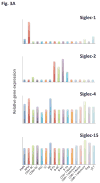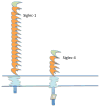Siglecs and immune regulation
- PMID: 22224769
- PMCID: PMC3781015
- DOI: 10.1146/annurev-immunol-020711-075018
Siglecs and immune regulation
Abstract
Sialic acid-binding Ig-like lectins, or Siglecs, vary in their specificity for sialic acid-containing ligands and are mainly expressed by cells of the immune system. Many Siglecs are inhibitory receptors expressed in innate immune cells that regulate inflammation mediated by damage-associated and pathogen-associated molecular patterns (DAMPs and PAMPs). This family also includes molecules involved in adhesion and phagocytosis and receptors that can associate with the ITAM-containing DAP12 adaptor. Siglecs contribute to the inhibition of immune cells both by binding to cis ligands (expressed in the same cells) and by responding to pathogen-derived sialoglycoconjugates. They can help maintain tolerance in B lymphocytes, modulate the activation of conventional and plasmacytoid dendritic cells, and contribute to the regulation of T cell function both directly and indirectly. Siglecs modulate immune responses, influencing almost every cell in the immune system, and are of relevance both in health and disease.
Figures

















References
-
- Sharon N. Advanced Book Program. Reading, Mass: Addison-Wesley Pub. Co; 1975. Complex carbohydrates, their chemistry, biosynthesis, and functions: a set of lecture notes; p. xix.p. 466.p. 7.
-
- Laine RA. A calculation of all possible oligosaccharide isomers both branched and linear yields 1.05 × 10(12) structures for a reducing hexasaccharide: the Isomer Barrier to development of single-method saccharide sequencing or synthesis systems. Glycobiology. 1994;4:759–67. The calculations made here emphasize the structural diversity that carbohydrates can generate. - PubMed
-
- Varki A. Sialic acids. In: Varki A, Cummings RD, Esko JD, Freeze HH, Stanley P, Bertozzi CR, Hart GW, Etzler ME, editors. Essentials of Glycobiology. Chapter 15. Cold Spring Harbor (NY): 2009. - PubMed
-
- Stamenkovic I, Seed B. The B-cell antigen CD22 mediates monocyte and erythrocyte adhesion. Nature. 1990;345:74–7. - PubMed
-
- Stamenkovic I, Sgroi D, Aruffo A, Sy MS, Anderson T. The B lymphocyte adhesion molecule CD22 interacts with leukocyte common antigen CD45RO on T cells and alpha 2-6 sialyltransferase, CD75, on B cells. Cell. 1991;66:1133–44. - PubMed
Publication types
MeSH terms
Substances
Grants and funding
LinkOut - more resources
Full Text Sources
Other Literature Sources
Medical

